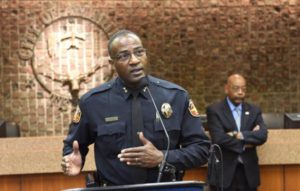Amarillo City Manager Jared Miller has a huge hiring decision to make soon. He needs to find someone to succeed Ed Drain as chief of the city’s police department.
Miller isn’t going to ask me for my advice, but I am going to give him just a bit of it here in brief form.
Mr. Manager, be sure the next top cop endorses community policing as a way to maintain the city’s relationship with the neighborhoods its officers swear to protect and defend.
Drain has been named the police chief of Plano, Texas, a burgeoning Dallas suburb. He went to Amarillo after serving for more than two decades with the Plano Police Department; he rose to the level of assistant chief.
Drain’s hiring in Amarillo was arguably the sole shining moment of former interim City Manager Terry Childers’ stormy tenure at City Hall. Childers took a hike and the city hired Miller from his city manager’s post in San Marcos.
Drain, meanwhile, reinstituted the community policing program that former Police Chief Robert Taylor let grow fallow during his years as the city’s top cop. I believe that was a regrettable policy decision on Taylor’s part, given the many miles the department had come under the leadership of his immediate predecessor, the late Police Chief Jerry Neal.
Community policing puts officers’ boots on the ground in the neighborhoods they patrol. They develop interpersonal relationships with residents. The policy is designed to build trust between law enforcement officers and the community … thus, the term “community policing.”
Drain has vowed to maintain the policy in Plano. As for Amarillo, I believe it is vital that it remain in force in that city.
I don’t know how Miller is going to conduct a search for a new police chief. He has some fine senior officers on staff already in the Amarillo PD. I actually have a favorite, if he’s willing to be considered for the post.
If Miller goes outside the department and looks far and wide, it would be my hope — no matter what he decides to do — that he insist that the next Amarillo police chief be as dedicated to community policing as Ed Drain was during his brief tenure there.
The policy works.







